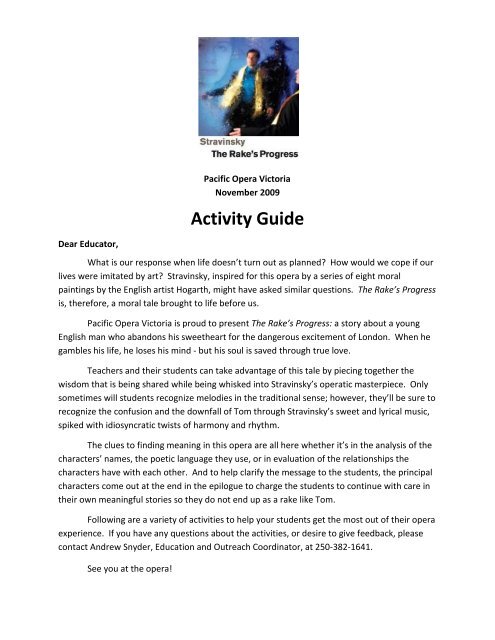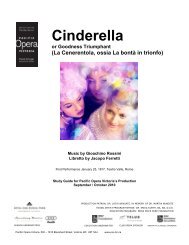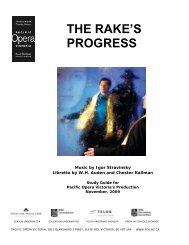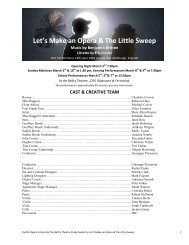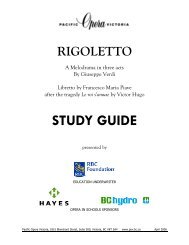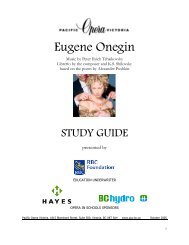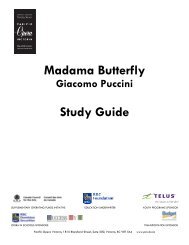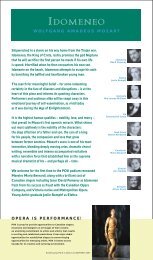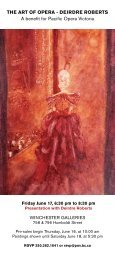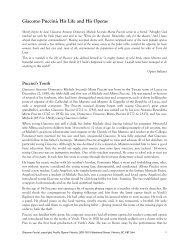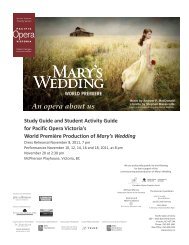Classroom Activity Guide - Pacific Opera Victoria
Classroom Activity Guide - Pacific Opera Victoria
Classroom Activity Guide - Pacific Opera Victoria
Create successful ePaper yourself
Turn your PDF publications into a flip-book with our unique Google optimized e-Paper software.
<strong>Pacific</strong> <strong>Opera</strong> <strong>Victoria</strong>November 2009<strong>Activity</strong> <strong>Guide</strong>Dear Educator,What is our response when life doesn’t turn out as planned? How would we cope if ourlives were imitated by art? Stravinsky, inspired for this opera by a series of eight moralpaintings by the English artist Hogarth, might have asked similar questions. The Rake’s Progressis, therefore, a moral tale brought to life before us.<strong>Pacific</strong> <strong>Opera</strong> <strong>Victoria</strong> is proud to present The Rake’s Progress: a story about a youngEnglish man who abandons his sweetheart for the dangerous excitement of London. When hegambles his life, he loses his mind - but his soul is saved through true love.Teachers and their students can take advantage of this tale by piecing together thewisdom that is being shared while being whisked into Stravinsky’s operatic masterpiece. Onlysometimes will students recognize melodies in the traditional sense; however, they’ll be sure torecognize the confusion and the downfall of Tom through Stravinsky’s sweet and lyrical music,spiked with idiosyncratic twists of harmony and rhythm.The clues to finding meaning in this opera are all here whether it’s in the analysis of thecharacters’ names, the poetic language they use, or in evaluation of the relationships thecharacters have with each other. And to help clarify the message to the students, the principalcharacters come out at the end in the epilogue to charge the students to continue with care intheir own meaningful stories so they do not end up as a rake like Tom.Following are a variety of activities to help your students get the most out of their operaexperience. If you have any questions about the activities, or desire to give feedback, pleasecontact Andrew Snyder, Education and Outreach Coordinator, at 250-382-1641.See you at the opera!
<strong>Activity</strong> OverviewPerformance Activities: The performance activities can be completed by thestudents by simply attending the opera.My Thoughts This activity allows the students to view, reflect, express, compareand contrast the drama, music and design of the specific scenes and artists. Theactivity comes with a ready matrix.Name That Voice! In this activity, students learn about different voice types andwill classify the voice types that they hear at the dress rehearsal.<strong>Classroom</strong> Activities: Activities designed for teachers that desire introduction orfollow up activities to the dress rehearsal of The Rake`s Progress.What’s in a Name? Students study the names of the characters for insight andclues on who these characters in the opera really are.3-2-1 Tableaux! Get your class moving! This will introduce (or reinforce) theartwork and story that inspired this opera.Character Development: Students begin to consider the process of characterdevelopment from an artist’s point of view.Rake’s Progress Word Find: A word find full of words from the opera!And the Moral of the Story is...An activity on the subject of morality in the opera.Debrief Activities: Use these debrief activities as prompts to get your studentsthinking, responding, relating and discussing their opera experience.Recall: Recollect facts, figures and concepts from The Rake’s Progress.A Rake’s Progress: The Rake’s Progress: Students compare and contrast thepaintings by Hogarth and the opera by Stravinsky.Free Think: Some discussion prompts for debrief.Point of View: Did Tom get what he deserved?What if....: Focused around the character and purpose of Nick Shadow.The Parent Trap: Do parents have a say in who we love?Time to let him go? Would Anne have been better without Tom?
The Rake’s Progress- My Thoughts<strong>Pacific</strong> <strong>Opera</strong> <strong>Victoria</strong>November 10 th , 2009Conducted by Timothy VernonReviewed by: ________________________The ArtistsColin Ainsworth - TomRakewellDescription of Character Description of VoiceLucia Cesaroni - AnneTruloveGregory Dahl - NickShadowChad Louwerse –TruloveMia Lennox-Williams -BabaRebecca Hass - MotherGooseBlaine Hendsbee –Sellem
The Scenes Drama Music DesignChapter 1 Star Rating Stars Rating Stars RatingThe Garden at the country cottage. 1-2-3-4-5 1-2-3-4-5 1-2-3-4-5My Thoughts:______________________________________________________________________________Chapter 2Mother Goose’s London Brothel 1-2-3-4-5 1-2-3-4-5 1-2-3-4-5My Thoughts:____________________________________________________________________________Chapter 5The street before Tom’s House 1-2-3-4-5 1-2-3-4-5 1-2-3-4-5My Thoughts:_____________________________________________________________________________Chapter 6Morning room with Baba and Tom 1-2-3-4-5 1-2-3-4-5 1-2-3-4-5and the new machineMy Thoughts:_____________________________________________________________________________The Auction 1-2-3-4-5 1-2-3-4-5 1-2-3-4-5My Thoughts:______________________________________________________________________________Chapter 7The Graveyard 1-2-3-4-5 1-2-3-4-5 1-2-3-4-5My Thoughts:___________________________________________________________________________Chapter 8Bedlam Institute 1-2-3-4-5 1-2-3-4-5 1-2-3-4-5My Thoughts:My compliment to the director, Glynis Leyshon, would be.....My compliment to the lighting designer, Gerald King, would be....My compliment to the costume designer, Nancy Bryant, would be...My compliment to the set designer, Allan Stichbury, would be...
Following are six common voice types.Name that Voice!Soprano: The highest female voice. Usually plays the heroine, a young woman or a girl in the opera. The high,bright sound suggests youth and innocence.Mezzo-soprano: The middle-range female voice. The mezzo, called an alto in choral arrangements, often plays awide variety of characters including gypsies, mothers, nurses, and even the part of young men.Contralto: The lowest female voice, similar to an English horn in range and tone color. Usually plays unique rolesincluding fortune-tellers, witches, and older women.Tenor: The highest male voice. Usually plays the hero or the romantic lead in the opera.Baritone: The middle-range male voice. Often plays the leader of mischief or the villain.Bass: The lowest male voice, similar to a trombone or bassoon in tone color. Usually portrays old, wise men, orfoolish, comic men.Listen to The Rake’s Progress cast and decide which category best fits each voice.ARTIST CHARACTER VOICE TYPEColin AinsworthTom RakewellLucia CesaroniAnne TruloveGergory DahlNick ShadowChad LouwerseTruloveMia Lennox-WilliamsBaba the TurkRebecca HassMother GooseBlaine HendsbeeSellemWhat do you think your voice type is? ______________________________________________
What’s in a name?The characters in The Rake’s Progress all have names that suggest to us who they are (evendown to the auctioneer)! Do research into the meaning of your own name and share with yourclassmates or a partner.My name: _____________________________________________________________________My name’s meaning: ____________________________________________________________Do you think the meaning of your name describes you? Why or why not?____________________________________________________________________________________________________________________________________________________________Before you see the opera, predict how the character will behave, based on their name.Afterwards, see how close your predictions were!Address the following aspects1. The character’s personality (eg. joyful, fearful, happy, risk taker, angry, sneaky, etc)2. The character’s appearance (eg. clean, dark, beautiful, character like, short, tall)3. An object that the character might use or holdCharacter: Thoughts before: Thoughts after:Tom Rakewell 1.2.3.1.2.3.Anne Trulove 1.2.3.Nick Shadow 1.2.3.Trulove (Anne’s Father) 1.2.3.Baba the Turk 1.2.3.Mother Goose 1.2.3.Sellem 1.2.3.1.2.3.1.2.3.1.2.3.1.2.3.1.2.3.1.2.3.
3-2-1 Tableaux!Look at the paintings of A Rake’s Progress on the following pages. These paintingsinspired Stravinsky to write his opera, The Rake’s Progress. In small groups of four to sixpeople, have the students create their own group tableaux of the following eight scenes. Set aspecified time (eg. 2 minutes) and have the students recreate the scene(s) by creating aphysically still picture of the painting while attempting to capture all the emotion. Havestudents present their tableaux to each other. You can have each group do (and present) onepainting each or assign each group one or two of the eight paintings.Extension Ideas:The Rake's Progress - Production by Canadian Robert Lepage - La Monnaie, April 2007• Blind Inspiration: Briefly overview the paintings by reading the painting descriptions tothe students. Have them create their own tableaux and afterwards compare withHogarth’s paintings.• Movie Scene on Mute: Have the students create one or two small repetitivemovements in slow motion so their tableaux suddenly become alive. Start the studentsin their tableaux and say, “And....action”. Students will then start their repetitivemovements.• Sound Effects: Have the students create sound effects that complement the smallrepetitive movements (still in slow motion). Have students perform their creation forthe rest of the group.
Plate 1 — The Young Heir Takes Possession Of The Miser's EffectsIn the first painting, Tom has come into his fortune on the death of his miserly father. While theservants mourn, he is being measured for new clothes. He is also rejecting the hand of hispregnant fiancée, Sarah Young, whom he had promised to marry (she is holding his ring and hermother is holding his love letters). He will pay her off, but it is clear that she still loves him.
Plate 2 — Surrounded By Artists and ProfessorsIn the second painting, Tom is at his morning hangout in London, attended by musicians and otherhangers-on all dressed in expensive attire. Surrounding Tom from left to right: a music master at aharpsichord; a fencing master; a quarterstaff instructor; a dancing master with a violin; an landscapearchitect; an ex-soldier offering to be a bodyguard; a bugler of a fox hunt club. At lower right is a jockeywith a silver trophy. The instructor looks disapprovingly on both the fencing and dancing masters. Bothmasters appear to be in the "French" style, which was a subject Hogarth loathed.
Plate 3 — The Tavern SceneThe third painting depicts a wild party under way at a brothel. The whores are stealing the drunkenTom's watch. On the floor is a night watchman's staff and lantern.
Plate 4 — Arrested For DebtIn the fourth, he narrowly escapes arrest for debt by Welsh bailiffs as he travels in a sedan chair to aparty. On this occasion he is saved by the intervention of Sarah Young, the girl he had earlier rejected.In comic relief, a man filling a street lantern spills the oil on Tom's head.
Plate 5 — Married To An Old MaidIn the fifth, Tom attempts to salvage his fortune by marrying a rich but aged and ugly old maid. In thebackground Sarah arrives holding their child while her indignant mother struggles with a guest.
Plate 6 — Scene In A Gaming HouseThe sixth painting shows Tom pleading for the assistance of the Almighty in a gambling den after losinghis "new fortune." Neither he nor the other obsessive gamblers seem to have noticed a fire breaking outbehind them.
Plate 7 — The Prison SceneAll is lost by the seventh painting, and Tom is incarcerated in the notorious Fleet debtor's prison. Heignores the distress of both his angry new "old" wife and faithful Sarah, who cannot help him this time.Both the beer-boy and the jailer demand money from him. Tom begins to go mad, as indicated by both atelescope for celestial observation poking out of the barred window and an alchemy experiment in thebackground
Plate 8 — In The MadhouseFinally insane and violent, in the eighth painting he ends his days in Bethlehem Hospital(Bedlam), London's celebrated mental asylum. Only Sarah Young is there to comfort him, butRakewell continues to ignore her. While some of the details in these pictures may appeardisturbing to modern eyes, they were commonplace in Hogarth's day. For example, thefashionably dressed women in this last painting have come to the asylum as a social occasion,to be entertained by the bizarre antics of the inmates.
Character DevelopmentThink about the characters of The Rake’s Progress and the role they play in the story.Choose one from the following characters that you would like to play in the opera.Anne TruloveTom RakewellNick ShadowMother GooseBaba the TurkTo help develop your character, answer the following questions on another piece of paper.Some clues are in the opera, but some of the other details need to be thought of and createdon their own. Be able to defend your answers.How old are you?Do you have brothers and sisters?What does your character typically like to eat?What sort of home do you have (house? /castle? /cave?) Describe it.What sorts of activities do you like to participate in?What is your most prized possession? Why?What is your purpose/objective in the opera? What steps in the opera do you take to achieve thispurpose/objective?What are your (character’s) greatest strengths?What are your (character’s) greatest weaknesses?Design your own question and answer it.
And the Moral of the Story is...Stravinsky was inspired for this opera by a series of eight moral paintings when he saw them ondisplay in Chicago in 1947. The Rake’s Progress is, therefore, a moral tale brought to life beforeus. Answer the following questions.1. What is the purpose of an epilogue? Why do you think Stravinsky included the epilogue(printed below) in this opera? Is it necessary?________________________________________________________________________________________________________________________________________________________________________________________________________________________2. Look at the production notes (see below in italics). What unique elements of characterand production are there in the epilogue when compared to the rest of the production?________________________________________________________________________________________________________________________________________________________________________________________________________________________3. Who do you think is giving the actual advice in the epilogue? Is it the charactersthemselves? The singers playing the characters? Stravinsky? The librettists (who wrotethe text for the opera)? A combination of these? Provide support for your answer.________________________________________________________________________________________________________________________________________________________________________________________________________________________________________________________________________________________________4. Read the epilogue a few times silently. Consider the advice each character is giving. Is itsound? What has driven them as characters to say this? Rewrite, in the boxes below, inyour own words, the advice each character is giving.Epilogue(Before the curtain. House lights up. Enter Baba, Rakewell, Shadow, Anne, Trulove - the men without wigs, Babawithout her beard)ALLGood people, just a moment:Though out story now is ended,There’s the moral to drawFrom what you sawSince the curtain first ascended.ANNEANNE:Not every rake is rescuedAt the last by Love and Beauty;Not every manIs given an AnneTo take the place of Duty.
BABABABA:Let Baba warn the ladies:You will find out soon or laterThat, good or bad,All men are mad;All they say and do is theatre.RAKEWELLBeware, young men who fancyYou are Virgil or Julius Caesar,Lest when you wakeYou be only a rake.RAKEWELL:SHADOW:ALLALL:So let us sing as one.At all times in all landsBeneath the moon and sun,This proverb has proved trueSince Eve went out with Adam:For idle handsAnd hearts and mindsThe Devil findsA work to do,A work, dear Sir, fair Madam,For you and you.TRULOVEI heartily agree, sir!SHADOWDay in, day out, poor ShadowMust do as he is bidden.Many insistI do not exist.At times I wish I didn’t.(Bow and Exit)FINIS5. Summarize in one sentence the moral message of the opera:________________________________________________________________________________________________________________________________________________________________________________________________________________________6. Do you agree with the advice being given? Why or why not?_______________________________________________________________________________________________________________________________________________________________________________________________________________________________________________________________________________________________
THINKRecall: Recollect facts, figures and concepts from The Rake’s Progress.Split your students into six groups. Give each group a large piece of paper and a marker. Assign each group towrite in big, bold letters, one of the following titles: Characters/Voice, Setting/Time Period, Set and CostumeDesign, <strong>Opera</strong> Atmosphere, Costumes and Plot. Have the students recall every detail that they can brainstorm fortwo minutes on their given topic. After two minutes, the students switch clockwise to the next sheet of paper.They must be careful to only add to each list. Hang the sheets up and use them to spring board a discussion abouttheir opera experience. Encourage the students to remember facts.A Rake’s Progress: The Rake’s Progress: Research and focus on the similarities and differences betweenHogarth’s “A Rake’s Progress” and Stravinsky’s “The Rake’s Progress”.Free Think: Students will enjoy starting the class with a discussion of the production of The Rake’sProgress. What did they like? What didn’t they like? Did anything surprise them? What would they liketo see or hear again? What would they have done differently? Facilitate the conversation and allowfreedom for the conversation to head where it needs to.Point of View: Hogarth, painter of A Rake’s Progress, often explored moral topics. He had clear ideasthat his characters would get what they deserved. Do you think that Tom Rakewell got what hedeserved? Do people get what they deserve in real life? Can you think of examples in your life, or in themedia where people either get or don’t get what they deserve?What if...: Tom Rakewell was greatly influenced by Nick Shadow. What if Tom had never met NickShadow? Do you think things would have turned out differently for Tom? Do you think Nick was truly abad influence or simply allowing Tom to follow his own ideas and choices?The Parent Trap: What is Trulove (Anne’s father) saying through the poetry? Do you think he is justifiedto have concerns about Tom’s love for Anne? What is a parent’s role concerning the hearts of theirchildren?Oh may a father’s prudent fearsUnfounded prove,And ready vows and loving looksBe all they seem.In youth we fancy we are wise,But time has knownThe hearts of others or our own.Time to let him go? Anne Trulove commits to Rakewell throughout the opera. Anne lets Tom go justbefore the epilogue and finally says her good-bye (Tom, my vow holds ever, but it is no longer I you need.Sleep well, my dearest dear. Good-bye). Should Anne have let Tom go earlier or was it noble of Anne tohang on to her love until the very last moments? Can you relate to the hope that Anne demonstrates?
Name:_______________________________ Date:_____________The Rake’s Progress Word FindWords are printed forward, diagonal and backwards! It’s harder than youthink. Mail completed form to address below for a special surprise!W X N S S A B B Q B U V R R P I M C E VR B X V E M R E T K A M W F I H H J L KY O W D E L A G W Y R B A Y F O H D R AH G R B S Y L A R G C A A X G N N H K JH O X L O P S E D Z E R X A T A O N R JI L I O O V T R M R H I R M X R W Y A DM Y C P G A R G L O X T B V S P N O K TF K V E M S A Y A R H O L R O O G L E PN D X R O X V N Y C H N V P I S H S S RA I R A O S I S O H N E V O L U R T A WN Y L Q A S N Y R E X G P U P M F N Q JN R X P H C S Q O S Q H P A Q T T B J WE V A A B R K S T T K Y I G R H P A J WE P D S L E Y B C R U N R A F E I Y Y EJ O O J B O N N U A T U R P A R H N R BW A C H T F N R D I Y A F V O R G T F CC H E U K U I D N Q R B U T O Z A G O ZP W D L Y D R G O J Q E C A Q E A B E MJ V C B D O S Y C N Y I I S H R O N E TS E P A C I F I C O V H N T X B L X Y IMail completed forms to:<strong>Pacific</strong> <strong>Opera</strong> VictoraAtt: Andrew SnyderEducation & Outreach Coordinator1815 Blanshard St., Suite 500<strong>Victoria</strong>, BCV8T 5A4RAKESHADOWSELLEMSTRAVINSKYHOGARTHSOPRANOTENORORCHESTRACONDUCTORANNEPAINTINGSLONDONMOTHERGOOSEBABAPACIFICOPERAVICTORIAROYALTHEATREBASSBARITONEARIATRULOVE
Reference Materials used in the <strong>Activity</strong> <strong>Guide</strong>:Auden, W.H and Kallman, Chester. The Rake’s Progress. New York: Boosey & Hawkes Inc., 1951.Stravinsky, Igor. The Rake’s Progress, vocal score. London: Boosey & Hawkes Inc. 1951.Wikipedia. A Rake’s Progress. Retrieved October 15, 2009.http://en.wikipedia.org/wiki/A_Rake%27s_Progress.http://www.lamediatheque.be/travers_sons/op_strv01.htm. Retrieved October 16, 2009.http://www.pov.bc.ca/. Additional information including a synopsis, musical excerpts andpictures of POV’s production designs are available at the POV website for further learning.
Teacher’s CommentsYour comments and suggestions are greatly appreciated. Please take a few minutes to fill out thisquestionnaire and return it to the address below. Thank you for your comments and suggestions.Name: ________________________________ School: _____________________________________Address: _____________________________________________________________________________Phone Number: ________________ Fax: ___________________ Grade(s) you teach: ________________Email: _____________________________________ Subjects: __________________________________Have you attended other arts events with your students in the past year? YesNoIf yes, what were they? __________________________________________________________________Were you able to use the Teacher’s Study <strong>Guide</strong> and <strong>Activity</strong> <strong>Guide</strong> in your classroom activities beforeattending the opera? Yes NoIf not, please elaborate: ___________________________________________________________________________________________________________________________________________________________________________________If so, which sections of the Study <strong>Guide</strong> and <strong>Activity</strong> <strong>Guide</strong> did you find most useful?____________________________________________________________________________________________________________________________________________________________________________________________________________________________________How appropriate was the information provided in the <strong>Guide</strong>s? ___________________________________________________________________________________________________________________________________________________________________________________________________________________________________________________________________What would you add/delete?____________________________________________________________________________________________________________________________________________________________________________________________________________________________________Did you spend classroom time discussing the performance after your students attended the opera? Yes NoDo you have any comments about the performance itself?____________________________________________________________________________________________________________________________________________________________________________________________________________________________________Would you like to receive information on our future Student Dress Rehearsals? Yes NoHow would you like to receive information? Fax Email Letters Other ______________Further comments and suggestions _____________________________________________________________________________________________________________________________________________________________________________________________________________________________________________________________________________________________Please return this form to:<strong>Pacific</strong> <strong>Opera</strong>, 1815 Blanshard Street, Suite 500, <strong>Victoria</strong>, BC V8T 5A4 Fax: 250.382.4944Or scan and email to asnyder@pov.bc.ca


